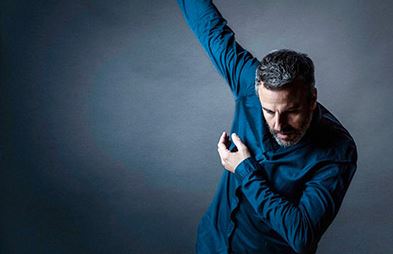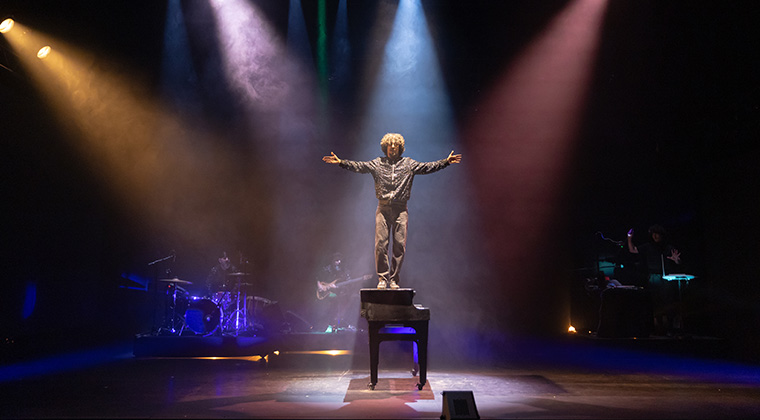
The dancer and choreographer Jesús Carmona had the collaboration of a group of experts from the University, the Clinic and the Cima University of Navarra for the development of Súper viviente, a show about dissociative identity disorder and other issues related to mental health. These researchers made their contributions from psychiatry, psychology, art education and neurology.
Carmona presented the absolute premiere of this show on September 26, 2024, with artistic co-direction by María Cabeza de Vaca.
Co-produced by the MUN and the Jesús Carmona Company and with the support of the Community of Madrid, Súper viviente was made possible thanks to members of the sponsoring board of trustees.
LEARN MORE
Related activities
More about Jesús Carmona's collaboration with researchers
The MUN: a meeting point between art and science, and between artistic disciplines.
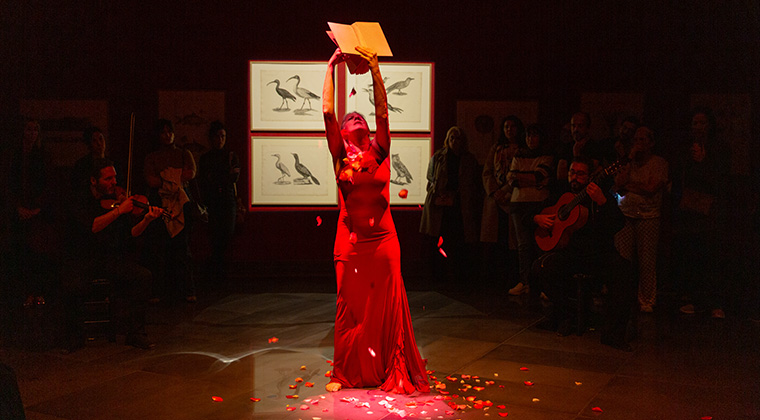
María Pagés and El arbi El Harti, invited by the artistic direction of Performing Arts and Music, are the authors of this choreographic creation project inspired by the exhibition A Promised Land, from the Age of Enlightenment to the birth of photography. The project is part of the Museum's artistic residency program.
Promised Land is a scenic intervention created specifically to interact with the exhibition of the same name A Promised Land. From the Age of Enlightenment to the birth of photography.
Produced by the María Pagés Company and the CCPM, in collaboration with Museo Universidad de Navarra, this performance choreography has an inclusive vocation. In it, choreographer María Pagés and playwright El Arbi El Harti invite flamenco dance, photography and museum scenography to conceive a new scenic semantics. They combine the fertile energy of flamenco dance with the aesthetic and ethical beauty of the museum and the exhibition in a hospitable alloy.
In Promised Land, dance approaches the genesis of photography, dialogues with it and sublimates it. Photography and dance share the same poetic essence and the same link with space, time, reality, movement and harmony? A photograph is a snapshot that tells a story. A choreography is the succession of snapshots that wish to tell the story from the ethical emotion of a creative imaginary.
The imaginary has always needed symbolically fertile territories. The Orient, undoubtedly, meets this requirement. It adapted very well to the existential need for estrangement that the West required in those times. The translation of The Thousand and One Nights, the edition of dictionaries, the writing of essays, the creation of plays, novels, poetry and short stories, the fascination for faraway countries, the diplomatic relations with the Porte, the intellectual interest in the Koran, are no other than the proof of this commitment to the discovery of a world located in deeply suggestive territories.
All this work, which began in the eighteenth century and had much of an almost convulsive creative tenacity, was an invitation to the other, through an aesthetic of the unknown, an aesthetic of exile, of rewriting.
The project was supported by Paula Orozco and Álex Ventós.
LEARN MORE
Video summary
Making of
The event
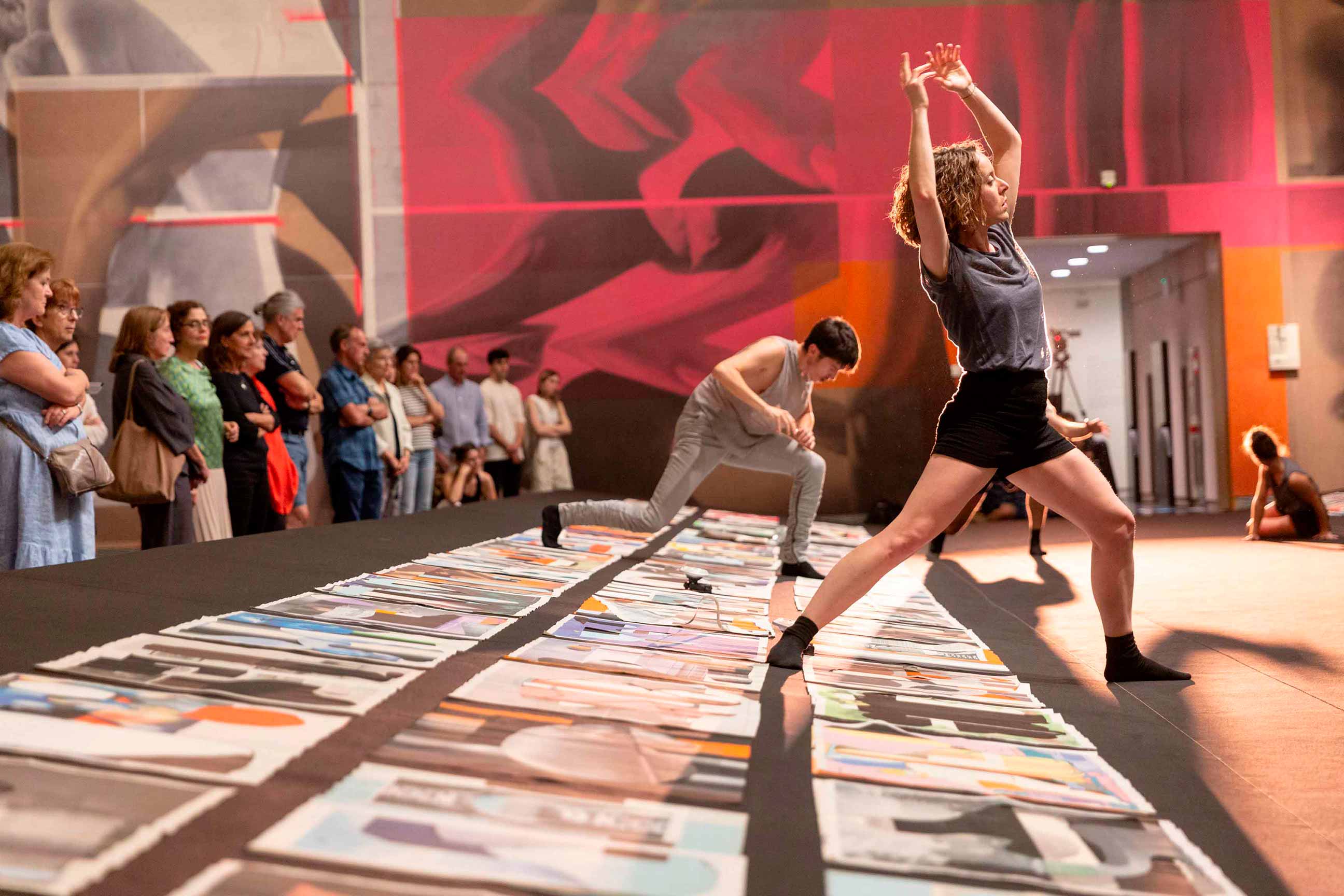
In the Museum's residencies, the artists' creations are inspired by pieces from the Museum's collection. On this occasion the project went further and generated a space for collaboration between the visual artist Fernando Pagola, with his exhibition Triple Concierto, and the choreographer and dancer Jon Maya.
Both artists shared their concerns and reflections on issues such as the movement of the human figure, the power of tensions and their embodiment in the body or the plasticity of the various artistic disciplines. Finally, on June 16, 2023, the choreographic intervention Tres Movimientos (Three Movements) was shared with the public in the framework of the Triple Concert exhibition. Both creations, the visual and the choreographic, merged in a dialogue in which the public took part.
To learn more:
The choreographer and dancer is inspired by Pharsalia, a poem by Lucan, a Cordovan author of the first century, to talk about war from an allegorical approach. To complete his research process prior to the choreographic creation, the choreographer relied on the research community of the University of Navarra. Philologists, archaeologists and philosophers joined the project, working together with the dancers, designers, lighting designers... In this way the project brought together the artistic and the academic approach.
The result of the creative process resulting from the residency was previewed at Museo Universidad de Navarra.
To learn more:
14 OCT '22/ 19:30H - Pharsalia. Antonio Ruz Company
11 OCT '22/ 19:00H - Cómo hacer cosas con... The poem Pharsalia by Lucan. With Olga García, Antonio Ruz and Álvaro Sánchez Ostiz.
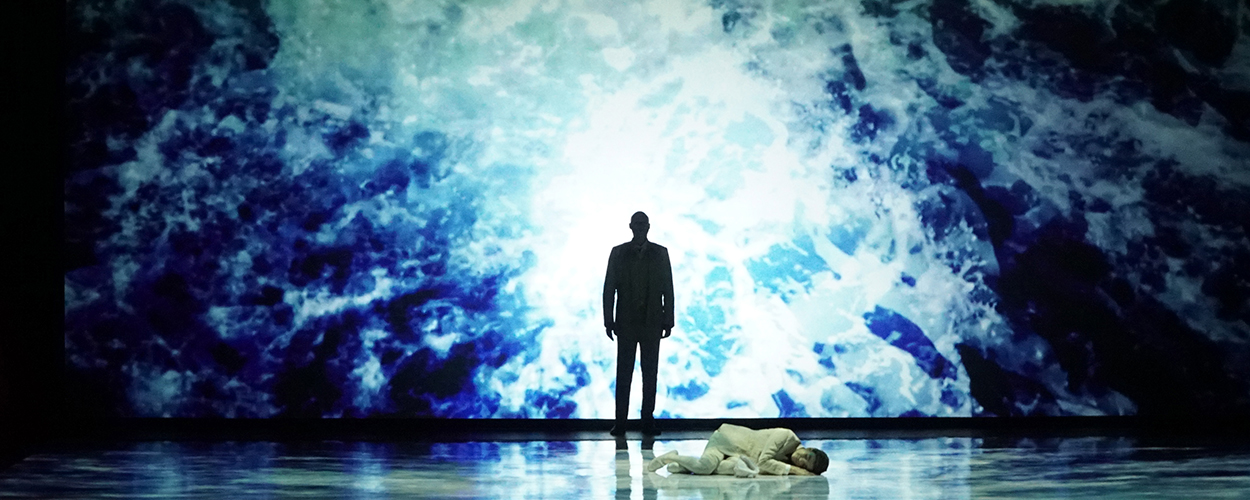
Scenic proposal:
Atlàntidaby Manuel de Falla.
Music by Manuel de Falla and Ernesto Halffter
Coproduction:
Chamber Choir of Pamplona and Museo Universidad de Navarra
The world premiere of Atlàntida in chamber version took place at Museo Universidad de Navarra on March 5, 2022, as part of the Cartografías de la Música (Cartographies of Music) cycle.
Previously "Atlàntida, en busca de la esencia" was presented on November 21st at the Gran Teatro Falla in Cádiz, within the framework of the XIX Festival de Música Española de Cádiz | Manuel de Falla, in a semi-staged chamber version, in a version for voice and piano four hands.
The project was supported by INAEM, the Government of Navarre, Pamplona City Council and the Archivo Manuel de Falla.
Access to the event information
Scenic notes of the Museum
This is the video summary of the event:
The piece arises from the concern of its authors to disseminate dance, to attract the public from the very conception of the work ... and for this they asked themselves: why not have the public from the first steps of the creative process?
To this end, a call was made to those people who, not being linked to the world of dance, were interested in participating in a process of this nature. The resulting group received the name and category of "Working Group" and participated in the creation of the piece in all its stages.
A good part of that working group were students from the University who highlighted the experience and became the best prescribers of contemporary dance.
The participatory process was a major challenge for the company, which established an ambitious schedule that began on September 17 and culminated with the premiere of the piece on November 6, 2021.
The piece was part of the cycle Museo en Danza 2021 and received two awards at the XXV edition of the Max Awards for the Performing Arts, Best Choreography and Best Lighting awarded to Nicholas Fischtel.
To learn more:
Access the event site
Site of the creative project on Campus
Max dossier of the work
Access to the event's press site
Access the summary of Museo en Danza 2021
La vida vivida y por vivir is a participatory theatre project born out of the concern of José Manuel Garrido, former artistic director of the Museum, who asked himself questions about the role of the elderly in our society in the wake of the pandemic.
He shared his concerns with Tomás Muñoz in order to respond to these concerns through art and theatre. Pepe Galera soon joined the project.
The artistic team carried out a casting among people over 60 years of age with no previous experience in theater. The group of participants, accompanied by the artistic team, carried out a process of reflection, concretion, creation and staging, which resulted in the play of the same title. The absolute premiere of the play took place on April 24, 2021 at the theater of Museo Universidad de Navarra.
The project aroused the interest of the media and other cultural agents. The experience will be replicated in the region of Murcia, and the group of new actors will tour Navarra, bringing the play to other localities.
The initiative was part of the QUIDARTE project, which was supported by the Obra Social la Caixa Foundation and the Caja Navarra Foundation.
Access the project development
Access to the Quidarte project summary
Access the MUN's digital content platform to watch the complete recording of the play.
El Cantar de Cantares is a poetic scenic proposal by director Ignacio García, who was invited to participate in the creative residencies program at Museo Universidad de Navarra. In this program, invited artists are inspired by the Museum's collection, spaces or projects to generate a new work.
Ignacio García visited the MUN Photographic Archive on 21 February 2020, following a previous visit in November 2019. Since then, conversations have taken place to give shape to this project. Thus was born El Cantar de Cantares, in the translation in eighth rhyme of Fray Luis de León, on photographs by José Ortiz Echagüe, whose collection belongs to the Museum's collection, and music by Ignacio García himself on melodies by George Gurdjieff, Antonio Vivaldi, Bárbara Strozzi, the Mancuso brothers, Nityn Shawney and others.
The public was able to attend the absolute premiere of the work, in work-in-progress format , on 23 January 2021. Subsequently, it was chosen as a representative piece of stage production in the Comunidad Foral for its presentation at the Almagro International Theatre Festival, where Navarre was the guest province.
In 2021, the International Theatre Meeting MITEM in Budapest, included the play in its VII edition as the only Spanish representation of the programme. Access to the clipping of the Meeting here.
The work is the result of the artist's residency at the Museum, which began at the end of 2019. The proposal has been supported by INAEM and Pamplona City Council.
The embrace of a girl and a man. This gesture of affection and sensitivity captured by José Ortiz Echagüe 's camera was the image that inspired the choreographer and dancer Daniel Abreu to create a site-specific piece developed in dialogue with the Museum's architecture and exhibitions. From tendernessa site-specific piece developed in dialogue with the Museum's architecture and exhibitions.
Abreu was captivated by a photograph from the Collection entitled La ternura (Tenderness). "I had some artistic concerns that had a lot to do with affection and I came across this photo. I was able to see different shades of development and it struck me that there was something in the gestures that gave rise to a much broader interpretation".
The dancers Dácil González and Arnau Pérez and the musician Hugo Portas accompanied him in the proposal, promoted by Teresa Lasheras, director of Performing Arts and Music at the Museum.
In Abreu's words, Desde la ternura does not propose "a representation of that photograph" but to share with the public "stories about tenderness": "Tenderness is the driving force, the concept I wanted to work on. But beyond that, there is a marvellous building, a fantastic architecture that allows us to move through many places. This physical, musical and theoretical framework began to move during these days of residence". In this sense, he pointed out that the creative process of this piece is "very liquid" and that "it generates many questions, above all in a context in which everything changes".
"(...) the live music by Hugo Portas, as well as the pre-existing music, which generates many atmospheres, the fixed choreographic material and the freedom of the performers are related around gestures that Ortiz Echagüe picks up: a hand that does not finish wrapping a girl and she, who does not finish touching a father or a grandfather". Thus, the piece offers interpretations that are above all questions about "why, what for, what is tenderness, what does it entail, where does it start from and where does it go".
The dancer Dácil González emphasised that "it is marvellous to transfer a physical material from a studio to the Museum: here it comes to life, transforming and adapting to each place. The architecture of the space, the content given to the space where we work and the way of inhabiting the place is very interesting", and for Arnau Pérez, it has been an "enriching work that has allowed me to take the body to different places or places that were more fragile for me. There has been a very interesting conversation about how the three bodies on stage change and how these conceptual ideas resurface".
Hugo Portas, who was in charge of the music performed live, pointed out that these were mainly baroque pieces, "versions translated to a contemporary instrument such as the tuba".
Abreu already presented his show in November 2020 The Sonas part of the cycle Museo en Danza, and facilitated a dance workshop during the same season.
Find out more...
More information about From tenderness
Access to the video summary of Museo en Danza 2020
JON MAYA
After the period of confinement, in October 2020 the public was reunited with dance in #Gauekoak, the piece by Kukai Dantza that closes this "chronicle of a confinement" and the artistic residency of Jon Maya's company at the. Museo Universidad de Navarra.
On October 10, 2020, with this piece, the third edition of Museo en Danza.
Access to the Gauekoak teaser and Jon Maya's Masterclass
The Creation Notebook dedicated to this projectwas published in October 2021.
The confinement experienced due to COVID-19 has exposed us all to new situations and challenges, which the creative community faces and interprets from its own perspective. This new situation was the subject of debate and reflection between Jon Maya, director of Kukai Dantza, and José Manuel Garrido, director of Performing Arts at Museo Universidad de Navarra.
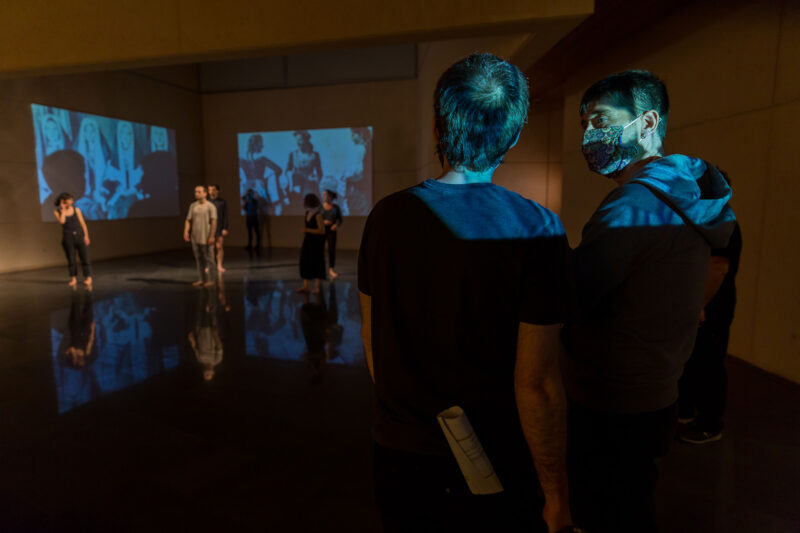
This reflective process, individual and shared, has given rise to an artistic residency project developed during the period of isolation, materialized in a week of intense work at the Museum to give rise to a new creation entitled 'A puerta cerrada', one of the first creations resulting from the artistic concerns of Kukai Dantza and Museo Universidad de Navarra in the historical context in which we live.
The process of creation unleashed in these conversations lives its own rhythm of de-escalation, adapting at each moment to the conditioning factors of the environment. Creation begins in the solitude of individual confinement, before reaching its particular "phase 1"; that moment when rehearsals begin separately, and each dancer experiences the impact of the reencounter with the physicality of dance and the joy of sharing the choreographic process, even without being able to meet physically. It is not until phase 2 that they meet again and enjoy sharing this choreographic work in the same space, the halls of the Museum.
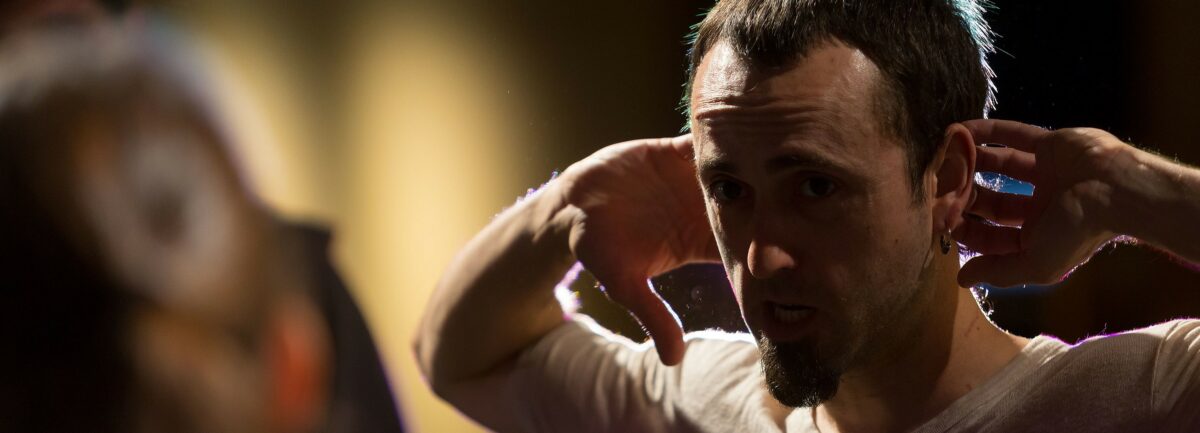
A puerta cerrada is materialized in three artistic pieces in the form of a trilogy. The first two, choreographic-audiovisual and in digital format, will be premiered online on June 12 and 19. Both are being worked on during an artistic residency in the Museum's own building between May 25 and June 1. And the third part is a piece by Jon Maya that will be premiered, foreseeably, at the Museum on October 10, this show will open "Museo en Danza" and will be an invitation to share live dance with the public.
The project as a whole is a creative process triggered by the crisis situation that engages in a dialogue with the Museum's architecture and with the exhibition "Universes" by David Jiménez and is inspired by the photographs of Roncalesas (1920) by José Ortiz Echagüe, belonging to the Museum's collection.
The artists themselves and the Museum's artistic direction will share their reflections with the public through three meetings, two of them digital, which will precede each of the pieces in the trilogy, with the aim of exploring them individually and facilitating their understanding as part of a whole.
Access to the meetings:
- José Manuel Garrido and Jon Maya frame the project.
- Jon Maya and David Jiménez, two artists facing the creative process.
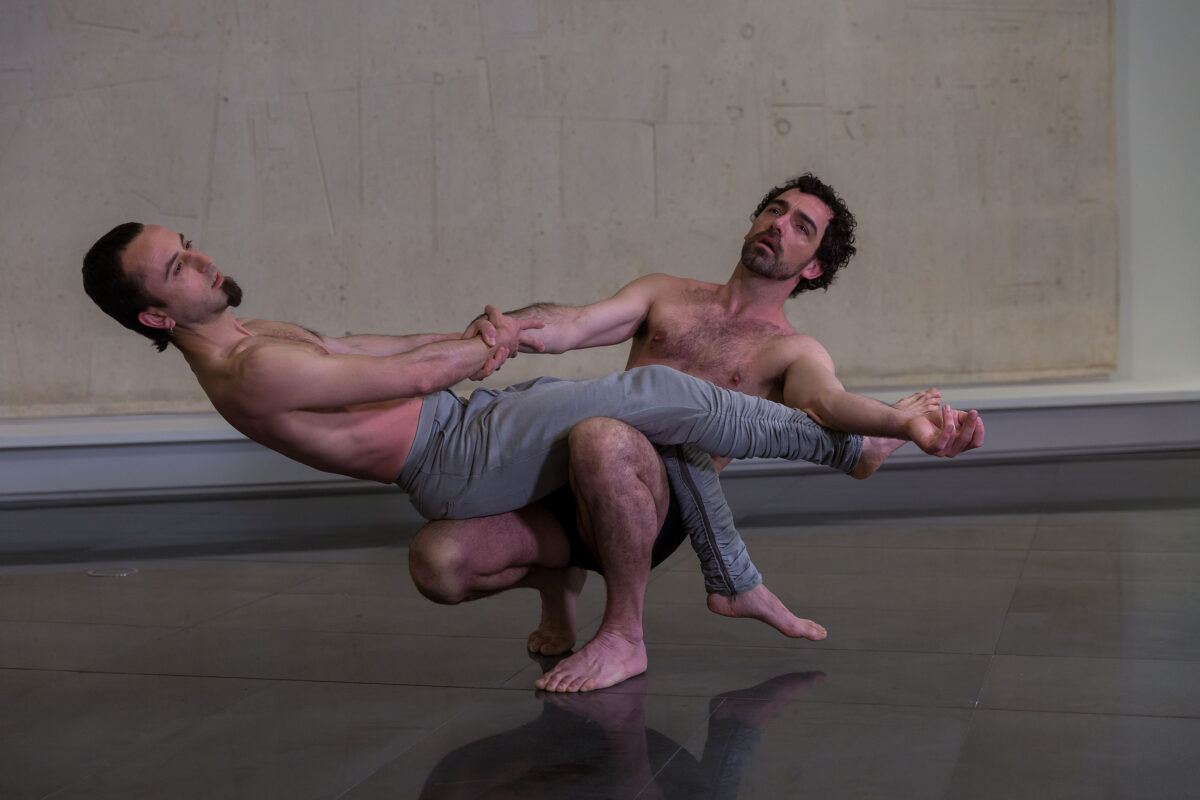
TODAY AND TOMORROW ARE YESTERDAY' / 'BIHAR, ETZI, ATZO DA' / 'BIHAR, ETZI, ATZO DA' / 'BIHAR, ETZI, ATZO DA'.
Ortiz Echagüe's photograph 'Las Roncalesas de 1920' inspired choreographer Jon Maya to create this piece. In it, three dancers personify the flu of the 20th century in an inner confinement. The artist constructs, through his dance, a story that links the pandemic context of the period photographed with the present and the future to which we are heading. The unstoppable wheel of time invites us to revisit a past that builds a bridge to a new future. The music, by the composer Luis Miguel Cobo, revolves around Bach, the artist who inspired Jorge Oteiza's famous 'Homage to Bach', a piece from the collection located in the room where part of this choreography takes place.
Access to Today and Tomorrow are Yesterday
-
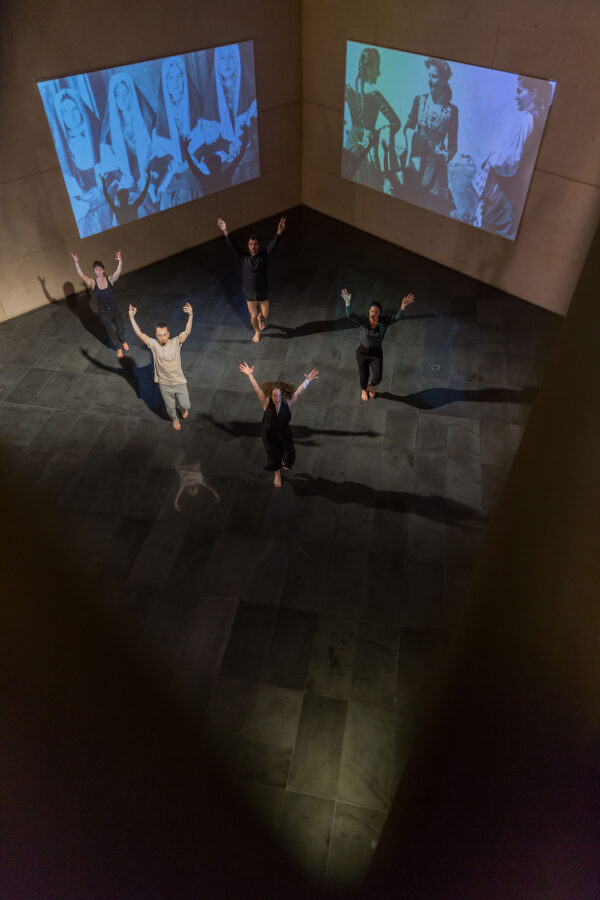
Dancers with Ortiz Echagüe's work in the background -
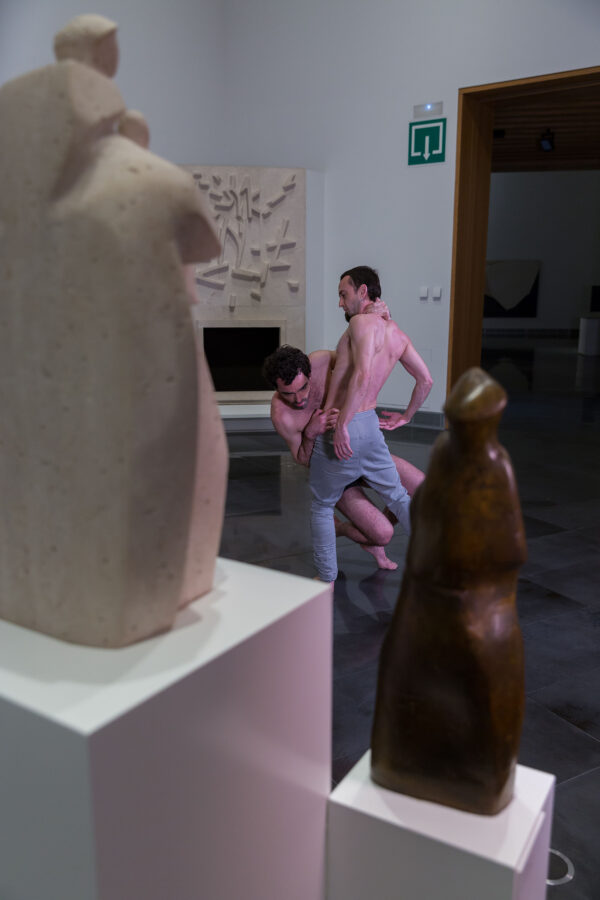
Dance in the Oteiza Hall -
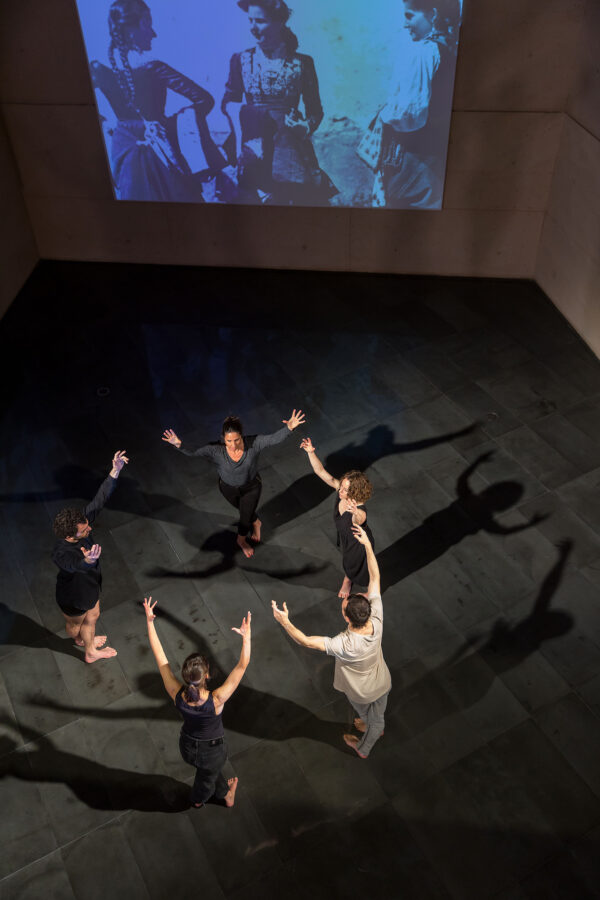
A moment of the choreographic-artistic process
SITUATIONS' / 'EGOERAK
The current pandemic has highlighted with particular insistence contrasts and concerns, dualities that accompany the human being: interior/exterior, darkness/light, solitude/contact, balance/imbalance. The situations experienced by all the people are translated into a movement that is in harmony with the architecture of the building and the exhibition 'Universes' by the photographer David Jiménez. A movement based on the contrast of light and dark, of the interior and exterior landscape, on the decontextualisation of one's own experiences from the opening towards new, sometimes uncertain, situations.
Access to Situations
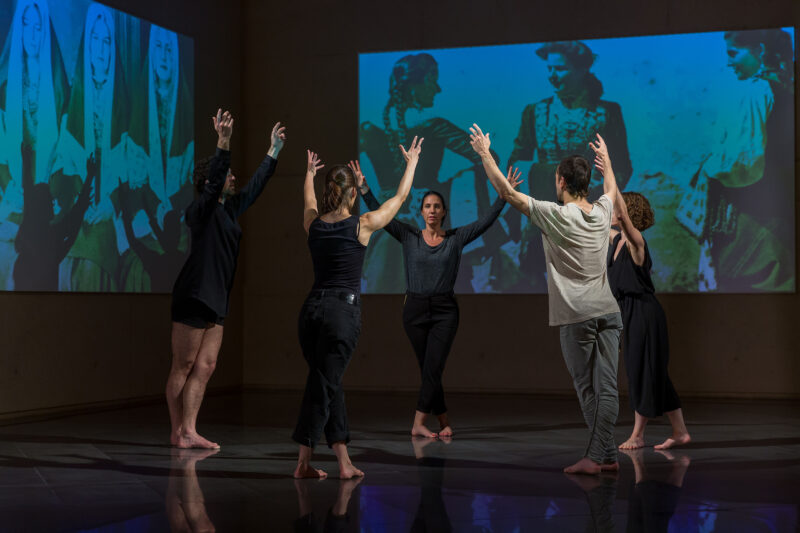
GAUEKOAK': chronicle of a confinement
Kukai Dantza's latest creation, 'Gauekoak', takes on new meaning and relevance in the light of events. The piece reflects the creative confinement of an artist during his process of reflection and experimentation. Taking the night and an everyday space as their habitat, the dancer Jon Maya and the musicians Xabi Bandini and Arkaitz Miner confront the confinement of the creator. They will perform live a piece with guest choreographers Israel Galván, Cesc Gelabert and Sharon Fridman.
This activity, developed on October 10, 2020 at the theater, opens the third edition of Museo en Danza, a cycle marked by thought, reflection and the reunion of the public and creators in the scenic spaces. A puerta cerrada' thus leads us, through its different formats, towards a new normality that will mark the live encounter between audience and creators.
Other materials:
Creation notebook. Jon Maya
Cycle Museo en Danza 2020
ANTONIO RUZ
Independent choreographer and dancer, he is one of the most outstanding creators of dance in our country. His discourse is based on an accentuated interest in the most open character of dance. An openness that is the result of both his extensive training and the development of his creative homilies, framed in contemporary dance, but also in Spanish dance and flamenco and in the meeting of both.
It was in 2009, the result of a personal and artistic need, when Antonio Ruz created his own dance company in Madrid. "My challenge in each project is to enhance the human side of the performers, to bare their personality. Technique and virtuosity without an underlying discourse don't interest me", explains the creator.
Among the mentions and awards that outline his career are the recent National Dance Award 2018 in the Creation Category and the "Ojo Crítico" Dance Award 2013 RTVE.
ARTISTIC RESIDENCY PROJECT
Taking as its starting point a selection of black and white photographs from the Museum's collection by various 20th century authors, the work proposes an evocative game through dance in which dancers dialogue with architecture, light and music in different spaces of the Museum.
"For years, my passion for photography has made this art form an important creative tool for me as a choreographer; the main source of inspiration for some of my work. I have always been fascinated by the exercise of transforming a flat image into the three-dimensionality of the body in movement and the connection between past and present that this process generates.
Antonio Ruz
Access to the video summary of the piece:
TRANSMUTATION 9/11/19 | 7:30 PM
Access to the video summary of the cycle Museo en Danza 2019
2023: Publication of the Creation Notebook "Transmutación" by Antonio Ruz.
SOLILOQUIOS / ISIL- HIZKETAK started as a project in the fall of 2017 with an invitation from José Manuel Garrido, artistic director of performing arts and music at Museo Universidad de Navarra, to Jon Maya, director of Kukai Dantza, to participate in the program of accompanying artists during the processes of creation. The transversality of artistic languages, art in movement, the connection with the university community and the recording of these processes are some of the main elements of this program. In the work generated, the Museum acts as a source of inspiration, support and channel for the birth of a living work.
In this project, Jon Maya had the collaboration of Israel Galván and Cesc Gelabert, three creators with very different registers and concerns that made this artistic project a pleasure for the public. The three highlighted that the richness of the collaboration had brought them a beautiful learning experience thanks to the contact with the other creators, a very close link with the public and the opportunity to integrate in their creation pieces of art closely linked to their own roots.
SOLILOQUIOS / ISIL- HIZKETAK premiered on May 23, 2019 at Museo Universidad de Navarra.
ITSASO A. CANO
Itsaso Álvarez Cano, director of the company ZUK PERFORMING ARTS, is a dancer and choreographer with a degree in Contemporary Choreography from the Conservatorio Superior de Danza María de Ávila. Itsaso is a multifaceted creator, she directs and choreographs stage shows, musical concerts, choreographies for cinema, video dance and video clips. In continuous training and research, the choreographer integrates her learning into her pieces.
Zuk was founded in 2012 in Madrid. The company stands out for its current proposals where it includes dance and the living arts through music, audiovisuals and direct contact with the audience, all of this together with its own choreographic language born from the encounter between urban dance and contemporary dance.
MATERIA
"Cover the memory with the mask of the one you will be,
and frighten the child you were"
- A. Pizarnik -
It is a haunting journey that delves into our feelings and questions our patterns of behaviour, claiming that we are much more than skin and bone. It premiered on 9 November 2018 at 19:30.
The piece gave rise to the publication Cuaderno de Creación by Itsaso A. Cano
ARTISTIC FILE
Direction and choreography: Itsaso Álvarez Cano
Musical composition: Sofía Comas, Guillermo Medín and Gonzalo Rivas (electronic music)
Costumes and lighting: Eleni Chaidemenaki
Dancers: Julia Lith, Ada Continente, Macarena Bielski, Selene Martínez, Jhonder Gomez y Marco Motta
Musical interpretation: Sofía Comas (singer)
Choir of dancers and collaborators from Navarre: Laura Sola, Ana Gutierrez, Margarita Gómez, Ainhoa Yuantao, Amaia Martinez, Anna Emmanuel, Irune Vazquez, Goizeder Azcarate, Anne Mendoza, Amaia Arbeloa, Izai Rodriguez, Paula Casajús, Ivan Navarro , Sara Ariño, Raquel Ordoñez, Iranzu del Valle de Miguel, Harritxu de Atxa Cancel
Production: Miguel PG
Production assistance: Vicente Romero
Photography and video: Harria Producciones
Other materials:
Video summary Museo en Danza, cycle in which Materia is presented.
Book: Creation Notebook
DANI PANNULLO
Dani Pannullo was born in Río Negro in the Argentinean Patagonia. Trained in dance and theatre in Buenos Aires and after long periods of research in the USA and Japan, he settled in Spain, where he has been living for more than twenty years, and it is in Madrid where he has developed his entire artistic career as a choreographer and stage director.
His inspiration has always been urban culture, to which he incorporates other dance expressions that he has encountered on his travels around the world, such as Japanese butoh, Egyptian dervish and flamenco, among others.
His company, created in 1999 with dancers from the most varied disciplines, has produced around twenty shows during his periods of residence at the Centro de Nuevos Creadores in Madrid and at the Centro de Danza Canal, with which he has participated in national and international festivals representing contemporary creation in Spain and abroad. In 2016 she gave an urban dance workshop at the Museum and brought to the theatre her show Avalanche.
ATLAS, MAP OF MOVES
Dani Pannullo's creation is inspired by the travels of the photographer José Ortiz Echagüe, where the artist captured the landscapes, roots and customs of the countries he visited with masterful scenographic composition. Panullo is inspired by Ortiz Echagüe's work to show the viewer the beauty of the static through the movements of these new forms of expression.
ATLAS Map of moves proposes a journey through the new techniques of corporal expression created by young people on the outskirts of cities all over the world. Greco-Roman wrestling, freestyle workout, B-boying and parkour present acrobatics, movements of great physical dexterity, risk and madness of great beauty that build a contemporary urban ballet inspired by the work of Ortiz Echagüe.
These forms of corporal expression have been born on beaches, parks and terraces all over the world and have managed to captivate many young people. For this reason, the show aims to construct an urban discourse that unites those who practise these techniques on a daily basis and who, for various reasons - geographical, social, educational, etc. - are distant from each other.
This piece premiered at the Museum on 16 November 2018 at 19: 30 and gave rise to Danni Pannullo's Creation Notebook.
Other materials:
Video summary of the Work in progress of the piece Atlas Map of Moves.
Video presentation Museo en danza
Martín's residency at Museo Universidad de Navarra generated three works -Control, Symptoma and Oximórica- and a constant of reflexive actions and developments. The traces and notes of the artist, some of his keys and obsessions were collected in the book "Cuadernos de Creación", first volume of the collection of the same name. In it, you can also browse through the images, landscapes or texts that inspire the author.
Galician choreographer and dancer Javier Martín premiered 'Control' on February 20, 2015, whose "work in progress" could be seen in November of the previous year.
Framed within the Madrid en Danza International Festival, the work was co-produced by the Museum and the consulting firm Artibus. As part of his artistic residency, the artist participated in a workshop and a conference on the research of the arts in movement.
With a scientific background and multiple conceptual interests, Martín approached this solo-improvisation and subsequent debate as a shared experience.
In 'Control' he develops the concept of transformation to create a solo seeking "to discover how this psychic energy is structured in the body; to find out how this energy remains immobile, potential, patterning and changing the location of the constant movement of homeostasis, its inherent kinetics or biodynamics".
The self-taught and eclectic choreographer also gave the weekend workshop 'The Phantom Body', with the collaboration of the University of Navarra.
